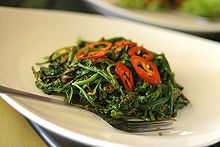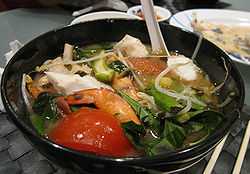Ipomoea aquatica
| Ipomoea aquatica | |
|---|---|
 | |
| Scientific classification | |
| Kingdom: | Plantae |
| (unranked): | Angiosperms |
| (unranked): | Eudicots |
| (unranked): | Asterids |
| Order: | Solanales |
| Family: | Convolvulaceae |
| Genus: | Ipomoea |
| Species: | I. aquatica |
| Binomial name | |
| Ipomoea aquatica Forssk. | |
Ipomoea aquatica is a semiaquatic, tropical plant grown as a leaf vegetable. It is found throughout the tropical and subtropical regions of the world, although it is not known where it originated. This plant is known in English as Water spinach, River spinach,[1] Water morning glory, Water convolvulus, or by the more ambiguous names "Chinese spinach", "Swamp cabbage" and "Kangkong" in Southeast Asia. [2] Occasionally, it has also been mistakenly called "kale" in English, although kale is a strain of mustard belonging to the species Brassica oleracea and is completely unrelated to water spinach, which is a species of morning glory. It is known as phak bung in Thai, "rau muống" in Vietnamese, trokuon in Khmer, kalmi shak in Bengali, and kangkung in Malay and Indonesian. In the Philippines, a variety of Kangkong is grown in canals dug during the American Occupation after the Spanish-American War, while another grows on land and is called "Chinese Kangkong".
I. aquatica grows in water or on moist soil. Its stems are 2–3 metres (7–10 ft) or more long, rooting at the nodes, and they are hollow and can float. The leaves vary from typically sagittate (arrow head-shaped) to lanceolate, 5–15 centimetres (2–6 in) long and 2–8 centimetres (0.8–3 in) broad. The flowers are trumpet-shaped, 3–5 centimetres (1–2 in) diameter, usually white in colour with a mauve centre. The flowers can form seed pods which can be used for planting.[3]
Cultivation

Ipomoea aquatica is most commonly grown in East and Southeast Asia. Because it flourishes naturally in waterways and requires little, if any, care, it is used extensively in Burmese, Thai, Lao, Cambodian, Malay, Vietnamese and Chinese cuisine, especially in rural or kampung (village) areas.
The vegetable is also extremely popular in Taiwan, where it grows well. During the Japanese occupation of Singapore in World War II, the vegetable grew remarkably easily in many areas, and became a popular wartime crop.
In non-tropical areas it is easily grown in containers given enough water in a bright sunny location. It readily roots from cuttings.
Invasive species
It has been introduced to the United States, where its quick growth rate has caused it to become an environmental problem, especially in Florida and Texas. It has been officially designated by the USDA as a "noxious weed".[4] In Sri Lanka it invades wetlands. Its floating, long stems form dense mats which can block the flow of water and prevent passage.[5]
Culinary uses


The vegetable is a common ingredient in Southeast Asian dishes. In Singapore, Indonesia and Malaysia, the leaves are usually stir-fried with chili pepper, garlic, ginger, dried shrimp paste (belacan/terasi) and other spices. In Penang and Ipoh, it is cooked with cuttlefish and a sweet and spicy sauce. Also known as Eng Cai in the Hokkien dialect. It can also be boiled with preserved cuttlefish, then rinsed and mixed with spicy rojak paste to become "jiu hu eng cai". Boiled eng cai also used to serve with fermented krill noodle "belacan bee hoon" and prawn noodle.[6]
Chinese cuisine (Chinese: 空心菜; pinyin: kōngxīncài; literally "hollow vegetable") has numerous ways of preparation, but a simple and quick stir-fry, either plain or with minced garlic, is probably the most common. In Cantonese, the water spinach is known as 通菜 (Jyutping: tung1 coi3) or 蕹菜 (Jyutping: ung3 coi3, sometimes transliterated as ong choy). In Cantonese cuisine, a popular variation adds fermented bean curd. In Hakka cuisine, yellow bean paste is added, sometimes along with fried shallots.
In the cuisine of Cambodia, where it is called trakuon (Khmer: ត្រកួន), water spinach is known to have a few types. The popular type is the usual local water plant, used in many traditional dishes. One type is known as Chinese trakuon grown as a straight stalk plant from soil. This type is known to be used in stir fry with pork or just with marinated soy beans (sieng). The Khmer popular dish samlar machu (sour soup) uses water spinach with fish or chicken. Water spinach is also eaten raw or parboiled along with other vegetables in dip dishes, e.g. toeuk kroeung, a sour/salty taste dish, with roughly minced fish mixed with lemon juice, crushed peanuts, basil and prahok (fish paste) flavour, similar to nam phrik.
In Thailand, where it is called phak bung (Thai: ผักบุ้ง), it is eaten raw, often along with green papaya salad or nam phrik, in stir-fries and in and curries such as kaeng som.[7]
In Laos, where it is known as pak bong (ຜັກບົ້ງ), and in Burma, where it is called gazun ywet (ကန်စွန်းရွက်; MLCTS: kancwan:rwak; [ɡəzʊ́ɴ jwɛʔ]), it is frequently stir-fried with oyster sauce or yellow soybean paste, and garlic and chillies.
In Vietnam, I. aquatica (rau muống) is a common ingredient and garnish in Vietnamese cuisine and was once served as a staple vegetable of the poor. In the South, the water spinach is julienned into thin strips and eaten with many kinds of noodles. It is also commonly cooked in a sour soup (Canh chua), with tomatoes, other vegetables, and some kind of protein. Rau Muống is also commonly sauteed with chopped garlic, oil (or pork fat) and fish sauce, and served as a side dish in many meals.
| Nutritional value per 100 g (3.5 oz) | |
|---|---|
| Energy | 79 kJ (19 kcal) |
| Carbohydrates | 3.14 g |
| - Dietary fiber | 2.1 g |
| Fat | 0.2 g |
| Protein | 2.6 g |
| Vitamin A equiv. | 315 μg (39%) |
| Thiamine (vit. B1) | 0.03 mg (3%) |
| Riboflavin (vit. B2) | 0.1 mg (8%) |
| Niacin (vit. B3) | 0.9 mg (6%) |
| Pantothenic acid (B5) | 0.141 mg (3%) |
| Vitamin B6 | 0.096 mg (7%) |
| Folate (vit. B9) | 57 μg (14%) |
| Vitamin C | 55 mg (66%) |
| Calcium | 77 mg (8%) |
| Iron | 1.67 mg (13%) |
| Magnesium | 71 mg (20%) |
| Manganese | 0.16 mg (8%) |
| Phosphorus | 39 mg (6%) |
| Potassium | 312 mg (7%) |
| Sodium | 113 mg (8%) |
| Zinc | 0.18 mg (2%) |
| Link to USDA Database entry Percentages are roughly approximated using US recommendations for adults. Source: USDA Nutrient Database | |
In the Philippines, kangkóng is also a common leaf vegetable in fish and meat stews, such as sinigang. It may also be eaten alone, such as in adobong kangkóng, where it is sautéed in cooking oil, onions, garlic, vinegar, and soy sauce. A local appetiser called crispy kangkóng has the leaves coated in a flour-based batter and fried until crisp, similar to Japanese vegetable tempura.[8]
In South India, the leaves are finely chopped and mixed with grated coconut to prepare thoran (തോരന്), a dish in Kerala. The same dish in Tamil Nadu is prepared as thuvaiyal (துவையல்) or as kootu (கூட்டு).
In Bangladesh and West Bengal, it is known as kolmishak (কলমীশাক) and stir-fried preparation of the leaves is a very popular dish.
Also known as Eng Cai in the Hokkien dialect. It is usually fried with fermented krill "belacan eng cai", boiled with preserved cuttlefish then rinsed and mix with spicy rojak paste "jiu hu eng cai",[9] boiled eng cai also used to serve with fermented krill noodle "belacan bee hoon" and prawn noodle.[6]
Hazard
The plant when eaten raw may transmit Fasciolopsis buski, an intestinal fluke parasite of humans and pigs, causing fasciolopsiasis.[10]
Medicinal uses
Studies conducted with pregnant diabetes-induced rats have shown a blood sugar lowering effect of Ipomoea aquatica by inhibiting the intestinal absorption of glucose.[11][12]
References
- ↑ "Adobong Kangkong (River Spinach) Recipe". Filipinofoodrecipes.net. Retrieved 2014-01-13.
- ↑ "Kangkong / Ipomoea aquatica Forsk./ POTATO VINE / Herbal Medicinal Therapies / Philippine Alternative Medicine". Stuartxchange.org. Retrieved 2014-01-13.
- ↑ "Kangkungking.com". Kangkungking.com. Retrieved 2014-01-13.
- ↑ http://plants.usda.gov/java/profile?symbol=IPAQ[]
- ↑ Gunasekera Lalith. Invasive Plants, A Guide to the Identification of the Most Invasive Plants in Sri Lanka, Colombo 2009.
- ↑ 6.0 6.1
- ↑ Nutritional composition of traditional Thai foods used local vegetables
- ↑ "Crispy Kangkong Recipe (River Spinach) - Filipino Recipes Portal". Pinoyrecipe.net. Retrieved 2014-01-13.
- ↑ Devil, The (2009-08-19). "016-3286699's Inbox: Rojak sotong kangkung". My.0163286699.com. Retrieved 2014-01-13.
- ↑ "Transmission: a Case Study of the Vuon-Ao-Chung Agricultural System on the Mekong Delta of Vietnam". Stanford University. 2002-04-28. Retrieved 2014-01-13.
- ↑ Sokeng, S.D.; Rokeya, B.; Hannan, J.M.A.; Junaida, K.; Zitech, P.; Ali, L.; Ngounou, G.; Lontsi, D. et al. (2007). "Inhibitory effect of Ipomoea aquatica extracts on glucose absorption using a perfused rat intestinal preparation". Fitoterapia 78 (7–8): 526–9. doi:10.1016/j.fitote.2007.06.011. PMID 17651914.
- ↑ Shivananjappa, Mahesh Mysore; Muralidhara (2012). "Dietary supplements of Ipomoea aquatica (whole leaf powder) attenuates maternal and fetal oxidative stress in streptozotocin-diabetic rats". Journal of Diabetes 5 (1): 25–33. doi:10.1111/j.1753-0407.2012.00210.x. PMID 22646693.
External links
| Wikimedia Commons has media related to Ipomoea aquatica. |
- Multilingual taxonomic information from the University of Melbourne
- Water spinach nutritional information from Kasetsart University
- Photo of heart-shaped variety
- Aquatic, Wetland and Invasive Plant Particulars and Photographs
- USDA Noxious Weed Regulations (Possession in USA requires permit)
- Species Profile- Water Spinach (Ipomoea aquatica), National Invasive Species Information Center, United States National Agricultural Library. Lists general information and resources for Water Spinach.
- Helminths and Helminthiosis of Pigs in the Mekong Delta Vietnam with Special Reference to Ascariosis and Fasciolopsis buski Infection
| Wikispecies has information related to: Ipomoea aquatica |